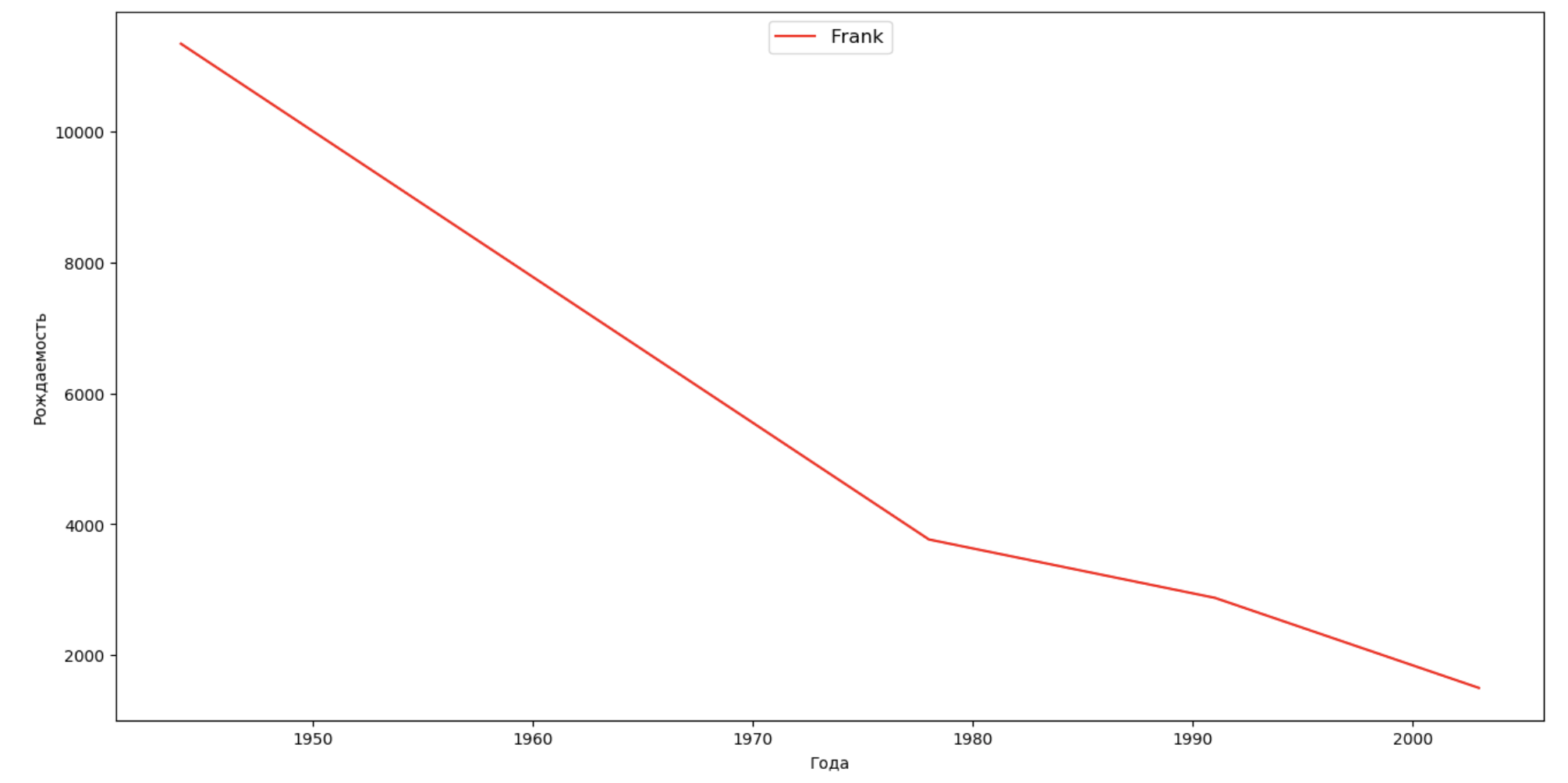
Hi Habr!
Today we will be working on the skill of using grouping and data visualization tools in Python. In the provided dataset on Github we analyze several characteristics and build a set of visualizations.
By tradition, we define goals:
- Group data by sex and year and visualize the overall fertility of both sexes;
- Find the most popular names in the history;
- Break the entire time interval in the data into 10 parts and for each to find the most popular name of each sex. For each name found, visualize its dynamics for all time.;
- For each year, calculate how many names cover 50% of people and visualize (we will see a variety of names for each year);
- Select 4 years from the entire span and display for each year the distribution of the first letter in the name and the last letter in the name;
- Make a list of several famous people (presidents, singers, actors, film heroes) and evaluate their impact on the dynamics of names. Build a visual visualization.
Less words, more code!
And let's go.
Group data by sex and year and visualize the overall fertility of both sexes:
import numpy as np
import pandas as pd
import matplotlib.pyplot as plt
years = np.arange(1880, 2011, 3)
datalist = 'https://raw.githubusercontent.com/wesm/pydata-book/2nd-edition/datasets/babynames/yob{year}.txt'
dataframes = []
for year in years:
dataset = datalist.format(year=year)
dataframe = pd.read_csv(dataset, names=['name', 'sex', 'count'])
dataframes.append(dataframe.assign(year=year))
result = pd.concat(dataframes)
sex = result.groupby('sex')
births_men = sex.get_group('M').groupby('year', as_index=False)
births_women = sex.get_group('F').groupby('year', as_index=False)
births_men_list = births_men.aggregate(np.sum)['count'].tolist()
births_women_list = births_women.aggregate(np.sum)['count'].tolist()
fig, ax = plt.subplots()
fig.set_size_inches(25,15)
index = np.arange(len(years))
stolb1 = ax.bar(index, births_men_list, 0.4, color='c', label='Мужчины')
stolb2 = ax.bar(index + 0.4, births_women_list, 0.4, alpha=0.8, color='r', label='Женщины')
ax.set_title('Рождаемость по полу и годам')
ax.set_xlabel('Года')
ax.set_ylabel('Рождаемость')
ax.set_xticklabels(years)
ax.set_xticks(index + 0.4)
ax.legend(loc=9)
fig.tight_layout()
plt.show()

Find the most popular names in the history:
years = np.arange(1880, 2011)
dataframes = []
for year in years:
dataset = datalist.format(year=year)
dataframe = pd.read_csv(dataset, names=['name', 'sex', 'count'])
dataframes.append(dataframe)
result = pd.concat(dataframes)
names = result.groupby('name', as_index=False).sum().sort_values('count', ascending=False)
names.head(10)

We divide the entire time interval in the data into 10 parts and for each we find the most popular name of each sex. For each name found, visualize its dynamics for the whole time:
years = np.arange(1880, 2011)
part_size = int((years[years.size - 1] - years[0]) / 10) + 1
parts = {}
def GetPart(year):
return int((year - years[0]) / part_size)
for year in years:
index = GetPart(year)
r = years[0] + part_size * index, min(years[years.size - 1], years[0] + part_size * (index + 1))
parts[index] = str(r[0]) + '-' + str(r[1])
dataframe_parts = []
dataframes = []
for year in years:
dataset = datalist.format(year=year)
dataframe = pd.read_csv(dataset, names=['name', 'sex', 'count'])
dataframe_parts.append(dataframe.assign(years=parts[GetPart(year)]))
dataframes.append(dataframe.assign(year=year))
result_parts = pd.concat(dataframe_parts)
result = pd.concat(dataframes)
result_parts_sums = result_parts.groupby(['years', 'sex', 'name'], as_index=False).sum()
result_parts_names = result_parts_sums.iloc[result_parts_sums.groupby(['years', 'sex'], as_index=False).apply(lambda x: x['count'].idxmax())]
result_sums = result.groupby(['year', 'sex', 'name'], as_index=False).sum()
for groupName, groupLabels in result_parts_names.groupby(['name', 'sex']).groups.items():
group = result_sums.groupby(['name', 'sex']).get_group(groupName)
fig, ax = plt.subplots(1, 1, figsize=(18,10))
ax.set_xlabel('Года')
ax.set_ylabel('Рождаемость')
label = group['name']
ax.plot(group['year'], group['count'], label=label.aggregate(np.max), color='b', ls='-')
ax.legend(loc=9, fontsize=11)
plt.show()










For each year, we calculate how many names cover 50% of people and visualize this data:
dataframe = pd.DataFrame({'year': [], 'count': []})
years = np.arange(1880, 2011)
for year in years:
dataset = datalist.format(year=year)
csv = pd.read_csv(dataset, names=['name', 'sex', 'count'])
names = csv.groupby('name', as_index=False).aggregate(np.sum)
names['sum'] = names.sum()['count']
names['percent'] = names['count'] / names['sum'] * 100
names = names.sort_values(['percent'], ascending=False)
names['cum_perc'] = names['percent'].cumsum()
names_filtered = names[names['cum_perc'] <= 50]
dataframe = dataframe.append(pd.DataFrame({'year': [year], 'count': [names_filtered.shape[0]]}))
fig, ax1 = plt.subplots(1, 1, figsize=(22,13))
ax1.set_xlabel('Года', fontsize = 12)
ax1.set_ylabel('Разнообразие имен', fontsize = 12)
ax1.plot(dataframe['year'], dataframe['count'], color='r', ls='-')
ax1.legend(loc=9, fontsize=12)
plt.show()

Select 4 years from the entire span and display for each year the distribution of the first letter in the name and the last letter in the name:
from string import ascii_lowercase, ascii_uppercase
fig_first, ax_first = plt.subplots(1, 1, figsize=(14,10))
fig_last, ax_last = plt.subplots(1, 1, figsize=(14,10))
index = np.arange(len(ascii_uppercase))
years = [1944, 1978, 1991, 2003]
colors = ['r', 'g', 'b', 'y']
n = 0
for year in years:
dataset = datalist.format(year=year)
csv = pd.read_csv(dataset, names=['name', 'sex', 'count'])
names = csv.groupby('name', as_index=False).aggregate(np.sum)
count = names.shape[0]
dataframe = pd.DataFrame({'letter': [], 'frequency_first': [], 'frequency_last': []})
for letter in ascii_uppercase:
countFirst = (names[names.name.str.startswith(letter)].count()['count'])
countLast = (names[names.name.str.endswith(letter.lower())].count()['count'])
dataframe = dataframe.append(pd.DataFrame({
'letter': [letter],
'frequency_first': [countFirst / count * 100],
'frequency_last': [countLast / count * 100]}))
ax_first.bar(index + 0.3 * n, dataframe['frequency_first'], 0.3, alpha=0.5, color=colors[n], label=year)
ax_last.bar(index + bar_width * n, dataframe['frequency_last'], 0.3, alpha=0.5, color=colors[n], label=year)
n += 1
ax_first.set_xlabel('alphabetic character')
ax_first.set_ylabel('frequency, %')
ax_first.set_title('The first letter in the name')
ax_first.set_xticks(index)
ax_first.set_xticklabels(ascii_uppercase)
ax_first.legend()
ax_last.set_xlabel('alphabetic character')
ax_last.set_ylabel('frequency, %')
ax_last.set_title('Last letter in name')
ax_last.set_xticks(index)
ax_last.set_xticklabels(ascii_uppercase)
ax_last.legend()
fig_first.tight_layout()
fig_last.tight_layout()
plt.show()


We will make a list of several famous people (presidents, singers, actors, film heroes) and assess their impact on the dynamics of names:
celebrities = {'Frank': 'M', 'Britney': 'F', 'Madonna': 'F', 'Bob': 'M'}
dataframes = []
for year in years:
dataset = datalist.format(year=year)
dataframe = pd.read_csv(dataset, names=['name', 'sex', 'count'])
dataframes.append(dataframe.assign(year=year))
result = pd.concat(dataframes)
for celebrity, sex in celebrities.items():
names = result[result.name == celebrity]
dataframe = names[names.sex == sex]
fig, ax = plt.subplots(1, 1, figsize=(16,8))
ax.set_xlabel('Года', fontsize = 10)
ax.set_ylabel('Рождаемость', fontsize = 10)
ax.plot(dataframe['year'], dataframe['count'], label=celebrity, color='r', ls='-')
ax.legend(loc=9, fontsize=12)
plt.show()




For training, from the last example you can add a period of celebrity's life to your visualization, in order to clarify their impact on the dynamics of names.
On this all our goals have been achieved and fulfilled. We have developed the skill of using grouping and data visualization tools in Python, and we will work with the data further. Conclusions on the already prepared, visualized data, everyone can make himself.
All knowledge!

